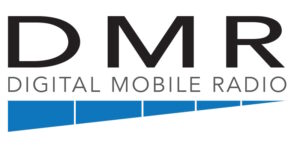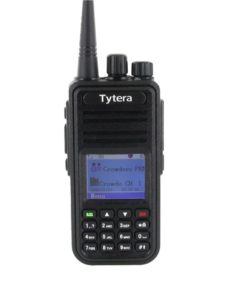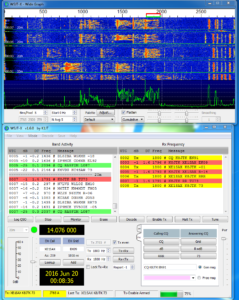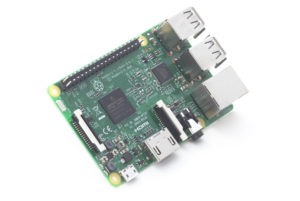One of the responsibilities of the Technical Coordinator in the Ohio Section is to submit something for the Section Journal. The Section Journal covers Amateur Radio related things happening in and around the ARRL Ohio Section. It is published by the Section Manager Scott – N8SY and articles are submitted by cabinet members.
Once my article is published in the Journal, I will also make it available on my site with a link to the published edition.
You can receive the Journal and other Ohio Section news by joining the mailing list Scott has setup. You do not need to be a member of the ARRL, Ohio Section, or even a ham to join the mailing list. Please sign up!
If you are an ARRL member and reside in the Ohio Section, update your mailing preferences to receive Ohio Section news in your inbox. Those residing outside the section will need to use the mailing list link above.
Updating your ARRL profile will deliver news from the section where you reside (if the leadership chooses to use this method).
Go to www.arrl.org and logon.
Click Edit your Profile.
You will be taken to the Edit Your Profile page. On the first tab Edit Info, verify your Email address is correct.
Click the Edit Email Subscriptions tab.
Check the News and information from your Division Director and Section Manager box.
Click Save.
Now without further ado…
Read the full edition at: http://arrl-ohio.org/news/2018/OSJ-Feb-18.pdf
THE TECHNICAL COORDINATOR
Jeff Kopcak – TC
k8jtk@arrl.net
Have a bunch of odds and ends for everyone this month.
Ham Cram Sessions
I received a piece of feedback worth sharing from December’s article on the “ham cram” type training sessions. One group in the section is working on a cram session for new licensees. That will be followed up with a “now what” session. The follow up session would have mentors and elmers available to help get new hams on the air. Depending on the success, this may be followed up with a General class too.
I think it’s a great idea to follow up with the “now what” session in a more relaxed environment for learning and getting them comfortable being on the air.
Digital Communications in Amateur Radio
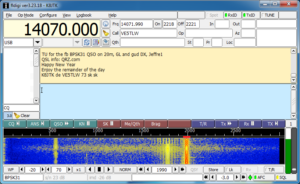
I’ve been working on my Digital Communications in Amateur Radio series for the Wood County Amateur Radio Club. The series started with an overview of Ham radio digital modes and how to get your station setup with different interface options. From there I’ve been taking an introductory look into specific modes, though mostly ones used on HF. My articles are available in the club’s newsletter, CQ Chatter, found on the Wood County Amateur Radio Club Website (past years are on the CQ Chatter Archives page) or available on my site as well. Check them out to get an introductory look at digital modes.
Latest additions:
- Conversational Digital Modes like PSK, RTTY, MFSK, Olivia (February 2017)
- Narrow Band Emergency Messaging System or NBEMS (August 2017)
- Winlink (February 2018)
Yaesu Fusion Announcements
After the New Year, Yaesu released an announcement with regard to their Fusion C4FM offerings.
- The DR-2X purchase program will continue through June 30, 2018.
- A trade-in program is available for current DR-1X repeater owners (they will not accept the beta version) towards the purchase of a DR-2X. $300 if you are trading in a DR-1X and only want the DR-2X repeater. If you wish to include the IMRS IP linking option in the DR-2X, the price will be $500.
- Buying the DR-2X outright is $900. $1100 to include IMRS.
- New Firmware will be released for DG-ID and DP-ID functionality in the DR-1X repeaters. Much like the Wires-X upgrade, it is very likely the repeater will need to be sent back to Yaesu for this firmware upgrade.
- They are releasing the DR-1X FR. The DR-1X FR is a “factory refurbished” DR-1X for $400. It will have the DG-ID and DP-ID firmware already installed. The DR-1X FR cannot be used for the trade in program towards a DR-2X.
The discounted prices listed for the DR-2X and DR-1X FR require an application available from Yaesu. Firmware upgrade details or applications can be obtained by contacting John Kruk – N9UPC (Sales Manager for Yaesu USA) at j.kruk@yaesu.com or through the Yaesu Service department.
Yeesh. Lost yet? I won’t rehash my thoughts on Fusion (see August & September 2017 editions of the OSJ) but I think this announcement only further fragments their offering.
Tom Gallagher – NY2RF to Retire
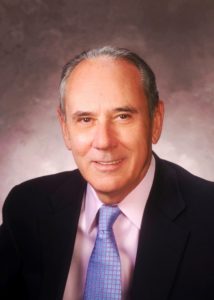 Tom Gallagher – NY2RF is going to retire after 2 short years as CEO of the ARRL. For me the cliché is true: it only seems like yesterday. I appreciated Tom’s articles in QST and his behind the scenes look at the ARRL. As an MBA, I loved his explanation into some of the financials and reasons for the league raising membership dues in 2016 (July 2017 QST, Mythbusting: ARRL Not “A Big Radio Club”). The League may have $14.7 million in assets but that doesn’t mean that is money lying around. It goes toward programs and services to benefit members and non-members alike. Despite the non-profit status our government affords the organization, they need to pay competitive wages to employees and authors – otherwise they will go elsewhere. I also had the privilege to correspond with Tom on, I think, an excellent direction to get Makers into the ham radio hobby.
Tom Gallagher – NY2RF is going to retire after 2 short years as CEO of the ARRL. For me the cliché is true: it only seems like yesterday. I appreciated Tom’s articles in QST and his behind the scenes look at the ARRL. As an MBA, I loved his explanation into some of the financials and reasons for the league raising membership dues in 2016 (July 2017 QST, Mythbusting: ARRL Not “A Big Radio Club”). The League may have $14.7 million in assets but that doesn’t mean that is money lying around. It goes toward programs and services to benefit members and non-members alike. Despite the non-profit status our government affords the organization, they need to pay competitive wages to employees and authors – otherwise they will go elsewhere. I also had the privilege to correspond with Tom on, I think, an excellent direction to get Makers into the ham radio hobby.
I wish Tom well in his retirement. Announcement: http://www.arrl.org/news/arrl-ceo-tom-gallagher-ny2rf-to-retire
Tinkercad
Speaking of Makers, I saw a video on the Amateur Logic podcast that demonstrated TinkerCAD electronics. If you’ve done anything with 3D printing, you’ve probably used Tinkercad. Tinkercad is a product of Autodesk, makers of software for architecture, engineering, and construction manufacturing. As Tommy demonstrates in the video, Tinkercad has an electronics section to simulate building electronic circuits and projects. This can be used as a great introduction into electronic circuit building for students and kids. The simulator has many types of electronic components: 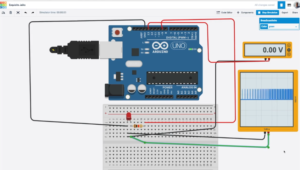 switches, capacitors, Arduinos, diodes, power supplies, oscilloscopes, potentiometers, resistors, ICs, breadboards, motors, servos, sensors, and of course – wires!
switches, capacitors, Arduinos, diodes, power supplies, oscilloscopes, potentiometers, resistors, ICs, breadboards, motors, servos, sensors, and of course – wires!
Tommy duplicates a simple blinking LED project he built in a previous episode using the simulator – even using the exact same Arduino code. I wondered if there was a product available to simulate circuit building and was quite impressed how well the simulator worked. Check it out in Amateur Logic episode 113. To sign up and start “tinkering,” go to: https://www.tinkercad.com/. 6 years or so ago, they were charging for the service. It appears when Autodesk took it over, it’s been free to use.
Scanner Anti-encryption Bill
Lastly for this month, I’m a scanner listener and I’m intrigued by the State of Ohio’s MARCS-IP public service safety system (Multi-Agency Radio Communications over IP). In short, it’s a state wide P25 digital communications system that allows users to be anywhere in the state and communicate with their agency. Once of the selling points for any commercial digital system is the ability to encrypt. Only those authorized can “unscramble” the transmission, meaning scanner listeners are locked out of listening to that particular group, or system in a few cases. Agencies love it and scanner listeners hate it.
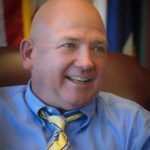
Our friends in the Colorado section made headlines last month when State Government Liaison and Section EC Robert Wareham – N0ESQ participated in drafting what is being called the “anti-encryption Bill.” With the backing of Colorado State Representative Kevin van Winkle (R), the bill outlaws blanket encryption by state and local governments striking a balance between transparency and the public’s right to monitor public agencies. Legitimate needs of confidential investigations and tactical operations are not protected under the bill. There are criminal penalties for those who monitor these communications to further a criminal enterprise, avoid arrest, detection, or escape capture.
While this bill only applies to Colorado, it could set a path for other states to draft something similar. Encryption for public radio systems is always a hot topic with completely valid points on both sides. There is a 51 page thread on the topic in the Radio Reference forums debating reasons both ways.
Thanks for reading and 73… de Jeff – K8JTK

